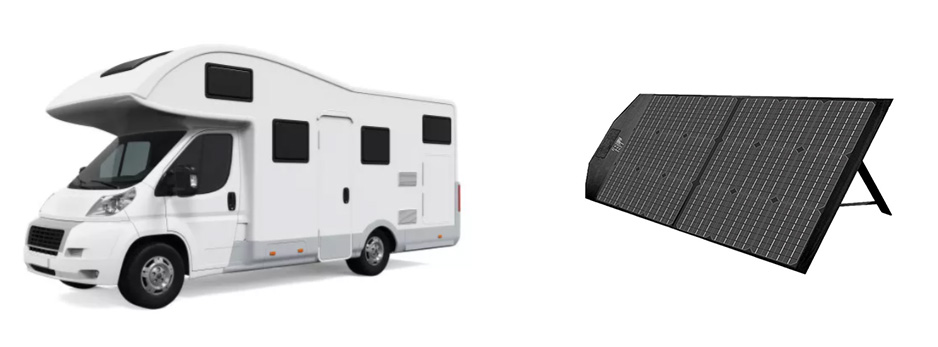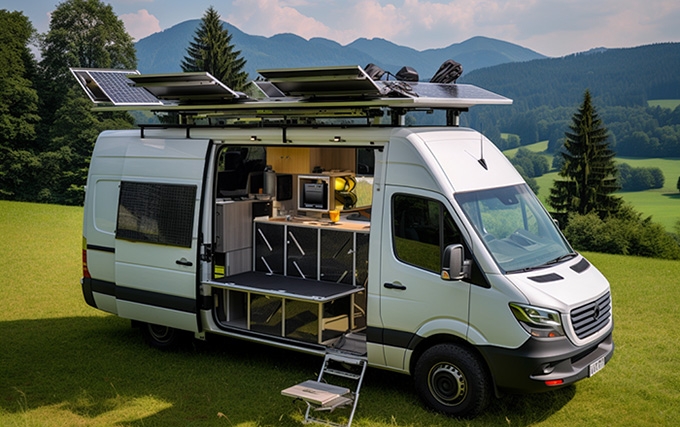Solar-powered RVs are becoming increasingly common at campsites, which is both expected and a sign of a future shift in camping practices. By harnessing free energy from the sun, RV enthusiasts can break free from the grid and enjoy a more liberating and eco-friendly camping experience. However, to maximize the benefits of a solar system, learning how to use solar energy efficiently is crucial. If you already recognize the cost-saving potential of solar power, you’ll be able to save even more once you master energy-efficient techniques. Home Power Inverter today will explore a series of expert tips to help you optimize solar energy use in your RV.
Appliance Selection and Energy-Saving Products
Switch to LED Lighting: LED lights have become the modern standard for lighting due to their excellent performance and energy-saving benefits. They have a long lifespan and consume far less power than traditional bulbs. For instance, a 5-watt LED light can provide brightness equivalent to a 100-watt incandescent bulb. This means you can significantly reduce the number of fixtures needed in your RV without sacrificing lighting quality. If your RV isn’t already equipped with LED lights, consider replacing all bulbs with LED ones to significantly cut down energy consumption.
Choose Energy-Efficient Appliances: Beyond lighting, other appliances in your RV should also be energy-efficient. For example, choose energy-efficient refrigerators, high-efficiency air conditioners, and low-energy cooking appliances. These not only consume less energy during use but also reduce the strain on your solar panels and battery system, extending their lifespan. When purchasing appliances, pay attention to energy efficiency labels and opt for products with higher efficiency ratings to lower your overall energy consumption.

Inverter Management
Add a Central Inverter Switch: Inverters, especially pure sine wave inverters, are the key devices for converting direct current to alternating current efficiently and stably, and are widely used in RVs. Pure sine wave inverters can generate pure sine wave current that is almost identical to the waveform of the utility power, thus ensuring that sensitive electrical equipment in RVs, such as TVs, computers, air conditioners, etc., can operate normally and remain undamaged. To address this, modern inverters usually come with power-saving modes. If your inverter lacks this feature, consider adding a central switch or turning the inverter off manually when not in use. Using the power-saving mode effectively and turning off the inverter after use can result in significant energy savings.
Use Inverters Efficiently: When using an inverter in your RV, it’s important to manage your power demands efficiently. Avoid running multiple high-power appliances simultaneously, as this can overload the inverter and increase energy consumption. Instead, stagger the use of appliances or opt for lower-power alternatives to reduce the inverter’s workload.
Battery System Optimization
Invest in Lithium-Ion Batteries: In an RV solar system, batteries are a key component. Compared to lead-acid batteries, lithium-ion batteries are more efficient at storing energy, require almost no maintenance, and offer better charging performance. Additionally, lithium batteries are lighter and safer to use. If you spend a lot of time in your RV, investing in lithium-ion batteries is a wise choice. Although the initial cost is higher, the superior storage capacity and long lifespan of lithium-ion batteries will prove more cost-effective over time.
Regular Inspection and Maintenance: Regardless of the type of battery used, regular inspection and maintenance are essential. Check for loose connections and ensure the battery system is in good working condition. Also, clean the battery surface regularly to prevent dust and dirt from affecting performance. Proper maintenance can extend battery life and improve energy efficiency.
Solar Panel Layout and Utilization
Maximize Sunlight Exposure: When parking your RV, ensure the portable solar panels are positioned to receive the maximum amount of sunlight. In the Northern Hemisphere, the RV should face north; in the Southern Hemisphere, it should face south. Avoid parking in shaded areas, as this can block sunlight and reduce the efficiency of the pv panels. By positioning the panels correctly, you can maximize the power generated by your solar system.
Utilize Natural Light Indoors: In addition to optimizing sunlight exposure for solar panels, you can also make use of natural light inside the RV. In the morning and afternoon, use natural light instead of electrical lighting to conserve energy. When designing an RV, consider installing large windows or skylights to increase the amount of natural light. Light-colored interior materials can also reflect light and make the space feel brighter.
Seasonal Adjustments: Depending on the season and weather conditions, you may need to adjust the position and angle of your photovoltaic panels. During colder months or cloudy days, the correct positioning of the RV solar panels becomes even more crucial to ensure sufficient power generation. In hot summer months, after the batteries have stored enough energy, you can park the RV in a shaded area to reduce indoor temperatures and minimize the need for fans or air conditioning.

Energy Management System
Smart Energy Monitoring: Installing a smart energy monitoring system can help you track the energy consumption in your RV in real-time. These systems typically display energy usage for each appliance, battery charge levels, and solar panel output. By monitoring this data, you can identify sources of energy waste and take steps to improve efficiency.
Create an Energy Plan: Based on your RV’s energy consumption and the output of your solar panels, create a well-structured energy plan. For example, fully utilize solar power on sunny days to store enough energy for nighttime use, and on cloudy or rainy days, limit the use of high-energy appliances to extend battery life. By planning and sticking to this strategy, you can ensure a stable and reliable energy supply in your RV.
Other Energy-Saving Tips
Use Insulation Materials: In RV design, using insulation materials can effectively reduce indoor temperature fluctuations. In summer, insulation helps prevent heat from entering, reducing air conditioning energy usage; in winter, it helps retain heat, minimizing the need for heating systems. Choosing high-quality insulation materials can significantly enhance your RV's energy efficiency.
Plan Your Route Wisely: When planning an RV trip, consider the energy demands along your route. For instance, spend more time in sunny areas to allow the solar panels to generate more power. In less sunny regions, reduce high-energy activities. By planning your itinerary thoughtfully, you can better utilize solar energy and reduce overall energy consumption.
Conclusion
Efficient use of solar energy in an RV can not only save energy costs but also reduce your environmental impact. By selecting energy-efficient appliances, managing your inverter properly, optimizing your battery system, positioning your solar panels effectively, and creating an energy plan, you can maximize the benefits of solar power. Inverter Online Store encourages RV enthusiasts to actively promote eco-friendly practices and contribute to the sustainable development of the camping industry. Together, we can create a greener, more sustainable future!
